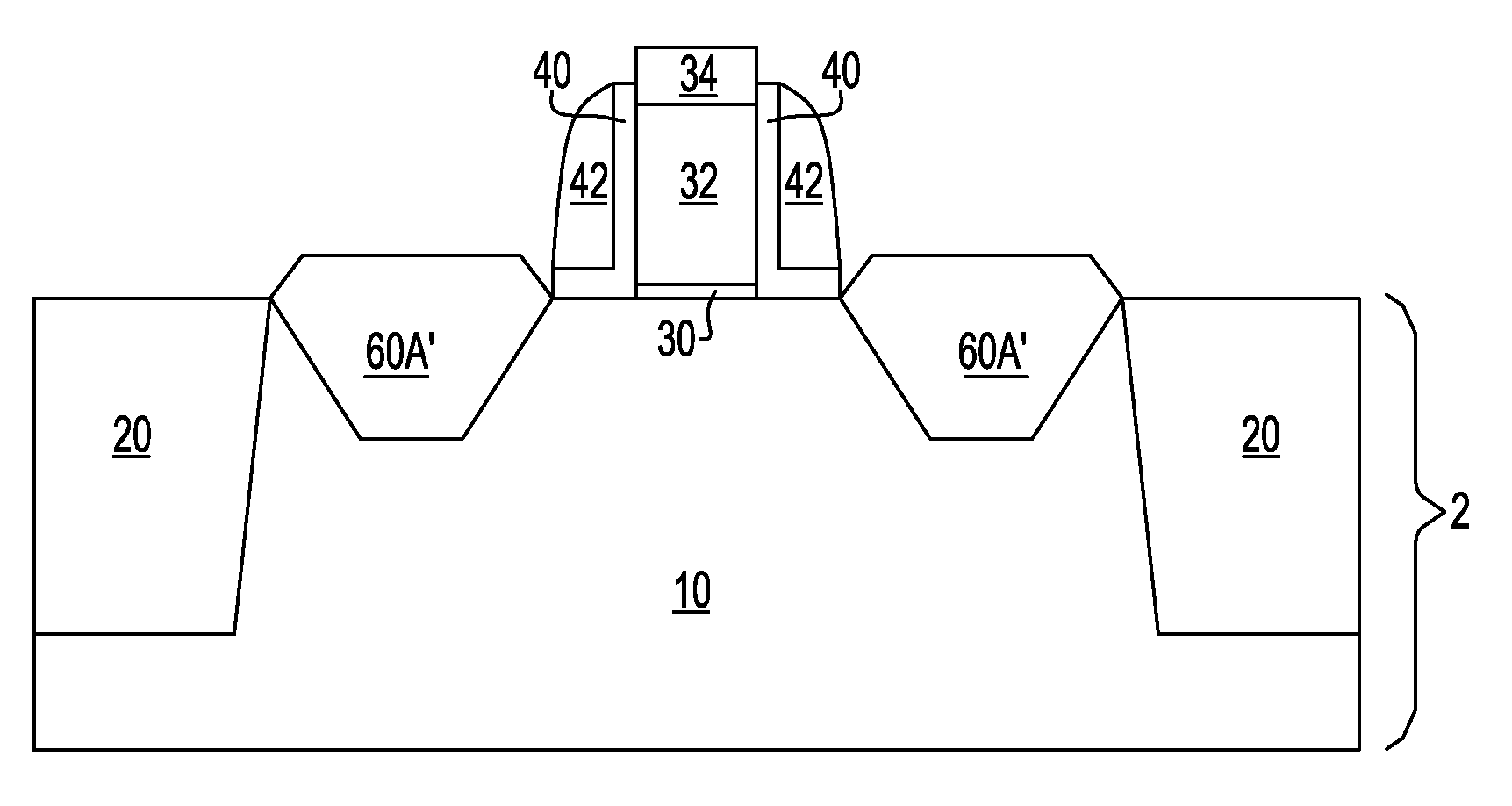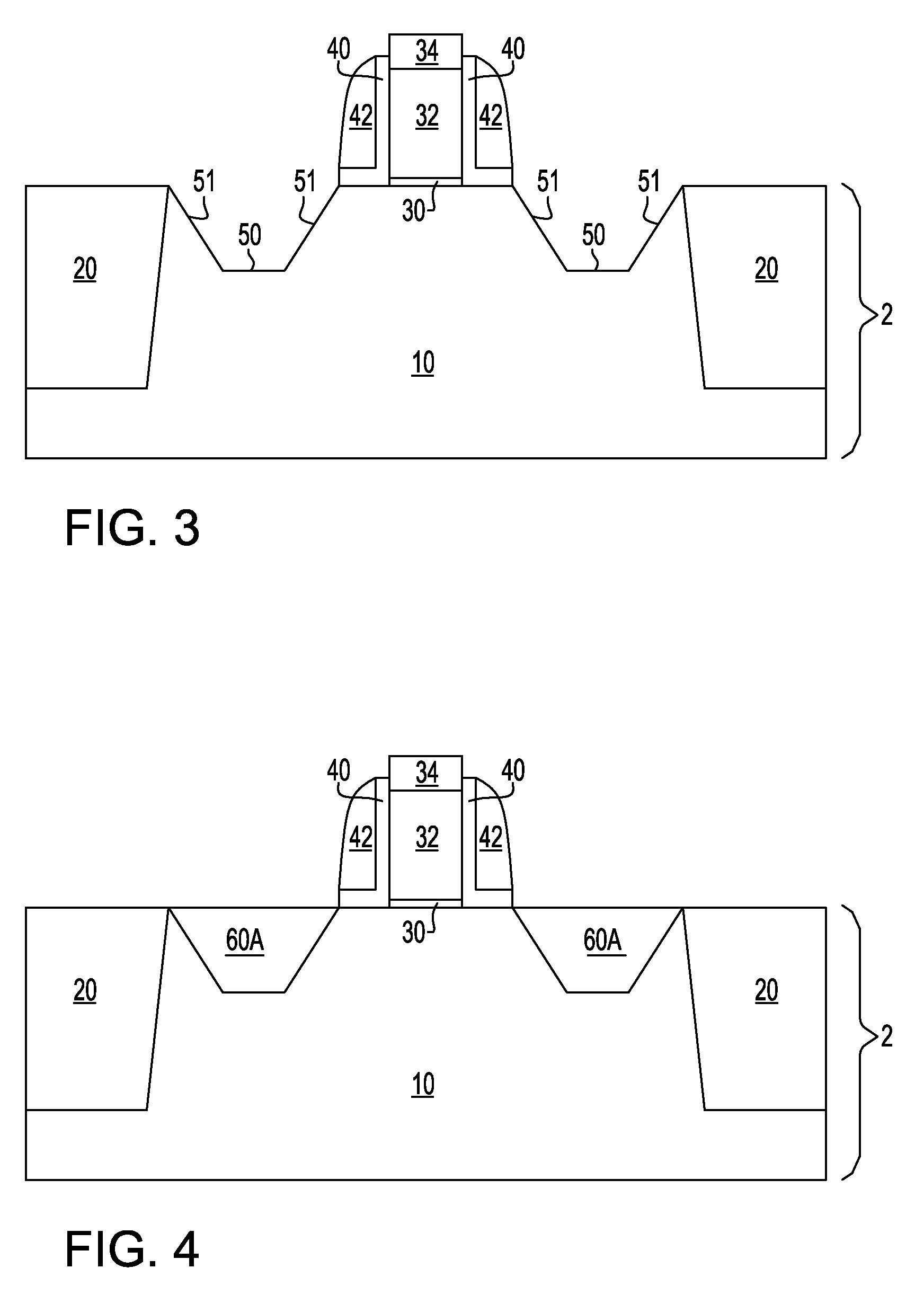Crystallographic recess etch for embedded semiconductor region
a crystallographic recess and semiconductor technology, applied in the field of semiconductor structures with at least one embedded semiconductor region, can solve the problems of junction leakage current to increase by orders of magnitude, facets on the semiconductor surface, adverse impact on the fet performance,
- Summary
- Abstract
- Description
- Claims
- Application Information
AI Technical Summary
Benefits of technology
Problems solved by technology
Method used
Image
Examples
second embodiment
[0063]Referring to FIG. 6, a second exemplary structure according to the present invention is shown. The semiconductor structure in FIG. 6 is formed by extending the crystallographic anisotropic etch after the first exemplary semiconductor structure shown in FIG. 3 is formed. The low etch rate crystallographic facet 51 in FIG. 3 extends further downward until the high etch rate crystallographic facet 50 is reduced to a ridge that joins the two low etch rate crystallographic facets 51. A V-shaped groove with a ridge in the middle is formed by the two low etch rate crystallographic facets 51 in an exposed semiconductor area. Thus, the crystallographic anisotropic etch produces at least one cavity surrounded by crystallographic facets adjoined by a ridge on the substrate semiconductor region 10.
[0064]Referring to FIG. 7, an embedded semiconductor material is deposited on the low etch rate crystallographic facets 51 of the substrate semiconductor region 10 preferably by selective epitax...
first embodiment
[0065]Through the same mechanism as in the first embodiment, the strained embedded semiconductor region 60B exerts stress on neighboring semiconductor structures. Also, the variety of the material that may be used for the embedded triangular semiconductor region 60B is determined by the crystal structure and the lattice constant of the substrate semiconductor region 10.
[0066]As in the first embodiment, each of the facets 51 (in FIG. 6) of the substrate semiconductor region 10 adjoins a facet of the triangular embedded semiconductor region 60B that is located directly across the boundary between the trapezoidal embedded semiconductor region 60B and the substrate semiconductor region 10. At a ridge where two facets belonging to the substrate semiconductor region 10 are adjoined, two other facets belonging to the triangular embedded semiconductor region 60B are also adjoined.
[0067]Referring to FIG. 8, a variant of the second exemplary semiconductor structure is shown, wherein the selec...
third embodiment
[0068]Referring to FIG. 9, a third exemplary structure according to the present invention is shown. The semiconductor structure in FIG. 8 is formed by subjecting the first exemplary semiconductor structure shown in FIG. 3 to a subsequent isotropic etch. During the isotropic etch, the substrate semiconductor material is removed at substantially the same rate along the various crystallographic orientations of the substrate semiconductor region 10. Preferably, the high etch rate crystallographic facets 50 are parallel to the original semiconductor surface 11. Alternatively, the high etch rate crystallographic facet 50 may not be parallel to the original semiconductor surface 11. The portions of the substrate semiconductor region 10 underneath the spacers (40, 42) are undercut during the isotropic etch. Further, the line at which a low etch rate crystallographic facet 51 adjoins the shallow trench isolation (STI) 20 is recessed downward along a sidewall of the STI 20. The cavity in the ...
PUM
 Login to View More
Login to View More Abstract
Description
Claims
Application Information
 Login to View More
Login to View More - R&D
- Intellectual Property
- Life Sciences
- Materials
- Tech Scout
- Unparalleled Data Quality
- Higher Quality Content
- 60% Fewer Hallucinations
Browse by: Latest US Patents, China's latest patents, Technical Efficacy Thesaurus, Application Domain, Technology Topic, Popular Technical Reports.
© 2025 PatSnap. All rights reserved.Legal|Privacy policy|Modern Slavery Act Transparency Statement|Sitemap|About US| Contact US: help@patsnap.com



